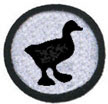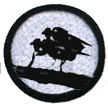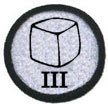Thursday 28 May 2009
New Darwinius t-shirts
Proceeds to The HMS Beagle Trust (UK Charity No. 1126192).
Why Darwinius is not our ancestor
Of course, it's not only us twitterers bemoaning the Darwinius hype machine; there's going to be a special Darwinius blog carnival on Monday, and I'm pleased to see a growing number of mainstream outlets casting a critical eye over the story, or at least giving space to external critics. For example, today I found an excellent opinion piece by Chris Beard the NewScientist called Why Ida is not the missing link. In it, Beard dresses down not just the hype - "unbridled hoopla" as he called it - but also the science itself. His final paragraphs are particularly good:
'So, Ida is not a "missing link" – at least not between anthropoids and more primitive primates. Further study may reveal her to be a missing link between other species of Eocene adapiforms, but this hardly solidifies her status as the "eighth wonder of the world".Great stuff. Great enough to make me shout "Yes!" out loud while alone in my flat. What Beard is saying here is that Darwinius is not the 'missing link' between anthropoid side of the primate family tree (including humans) and the lemur side because the authors of the paper in which Darwinius is described have not convincingly demonstrated that she belongs with the former and not the latter. Beard contends that the balance of evidence keeps Darwinius - and all the rest of the adapiforms by extention - anchored firmly on the lemur line. To explain this, he provides this useful diagram of primate evolutionary history:Instead, Ida is a remarkably complete specimen that promises to teach us a great deal about the biology of some of the earliest and least human-like of all known primates, the Eocene adapiforms. For this, we can all celebrate her discovery as a real advance for science.'
Evolutionary tree diagram reproduced from NewScientist.
The diagram shows the two competing hypotheses: the red dot in the diagram indicates where Chris Beard contends Darwinius belongs, on an early branch in the lemur (brown) lineage. The paler spot with the "?" indicates where the paper's authors claim Darwnius belongs, as an early member of the (blue) anthropoid lineage and, specifically, as they have contended in interviews and on their website if not in their paper, ON the line. In other words, they claim she is our direct ancestor.
I don't have any professional background in primate anatomy but I find Beard's argument - especially in combination with Laelaps' analysis - pretty compelling, certainly compelling enough to remain very skeptical of the authors' conclusions. We will have to wait for further analyses of the Darwinius specimen, however, before this controversy can be more soundly resolved.
But here's the thing: even if upon further analysis Beard is shown to be mistaken and the authors are right about Darwinius and her fellow adapids being on the anthropoid lineage, she will still not necessarily be the 'missing link', nor - perhaps more importantly because it actually means something - 'our ancestor'. To explain my point, I re-drew Beard's diagram:

I re-drew it this way for the simple reason that, considering the abundance of species upon the Earth at any one time, it would be very unusual for us to find a fossil on our direct ancestral line, rather than on a branch off of that line. As John Wilkins put it, "There is no missing link. Rather, there are an indefinite number of missing branches. [snip] We might have a species that is an ancestor of some other species, and yet not know enough to say that they are indeed the ancestor in question."
Additionally, as Richard Carter notes, Ida herself can't be our direct ancestor because she died as a juvenile. But as I've just explained, even her whole species is very unlikely to include our ancestor.
Interestingly, as I mentioned in passing above, the hype machine (including the paper's authors themselves when interviewed) puts Darwinius directly on the line to us, while in Supplementary Figure 7 in the PLoS ONE paper, the authors put Darwinius on a early branch off the line. In other words, what they're saying in public isn't just hyped up, it's fundamentally different from what they're saying in the paper itself.
To summarize, if Darwinius is found, as the authors contend, to belong on 'our' side of the primate family tree (and even that conclusion is shaky) she is not a 'missing link' (because there's no such thing), and she is very unlikley to be our ancestor.
Tuesday 26 May 2009
Darwinius has left the building
The brief display was occasion for a press conference (or is it the other way around?), but there was also a short time during which staff were invited to view
Upon realizing that "the lucky scientists" might in fact include me, I leapt towards the telephone to call a colleague in the NHM press office to find out how long it would be on display today. Annual leave or no, if there was a chance to see it, I was going to get onto my bicycle and get myself over there pronto!Visitors to the Natural History Museum in London will be able to see Ida, the fossil of the ancient lemur-like creature, when a cast goes on display from tomorrow.
[snip][snip]
The Ida cast was donated to the Natural History Museum today by the University of Oslo Natural History Museum. Sir David Attenborough will be there to see the cast and is also narrating Uncovering Our Earliest Ancestor: The Link, a one-off documentary about Ida on BBC One at 21.00 tonight.
Scientists at the Natural History Museum, London, will get a glimpse of the real specimen when it is brought to the Museum for just a few hours.
The lucky scientists will see the most complete fossil primate ever found. It is so well-preserved that the remains of its last meal are still in its stomach and you can see an outline of where the fur once was.
You can imagine how I felt when my colleague told me that the staff viewing time had ended at 2pm and that the fossil was no longer in the building. Actually, you don't have to imagine how I felt because my disappointment is documented for posterity on twitter (thanks to Rowan and Mun-Keat for the consolatory tweets).
The wave of disappointment that washed over me, though, was quickly followed by introspection. Why was I so disappointed? Had I actually succumbed to the hype? I could tell you (and more importantly, myself) that I was just disappointed not to get to see a beautiful, complete 47-million-year-old primate fossil, but if I'm honest, I have to admit that I also wanted to see the the source of all the commotion and get to feel like an insider. So I did succumb, but more in the way gawkers slow down to look at traffic accidents than in an "OMG THE MISSING LINK" way. Following this analysis, I felt a little less disappointed. Hooray for analysis!
Of course, this doesn't mean that tomorrow morning on my way up to my newish digs in Phase II of the NHM's Darwin Centre I won't stop off and have a look at the cast of Darwinius, which, though not the real thing is still one of maybe only two casts in the world (the other at the AMNH in New York).
But seeing the cast won't quite make up for not seeing the real thing (Rowan Hooper tweets that the cast doesn't quite do the original justice), and I still will have missed the press conference, which would have been interesting because, judging by the BBC video coverage, Jørn Hurum (the most hyperbolic of the scientific authors) and David Attenborough seem to be toning down the hype a little:
Attenborough even says - tellingly - that Darwin "would have been absolutely riveted by it - I have no doubt about that, and he would - I am sure - have sat and looked at it and thought about it - probably for a decade - before he said anything about it. Maybe that's quite a wise thing to do." Might this final sentence signal that David Attenborough feels a twinge of regret about the way the project was handled?
Similarly, Rowan Hooper's blog and video coverage of the event shows Hurum apparently backpedaling a bit in the face of recent criticism that the paper was weak on evolutionary analysis - I can only imagine he's referring to Brian Switek's excellent critques of the scientific paper - by claiming that this only ever meant to be a descriptive paper and that a more rigorous phylogenetic analysis was still in the pipeline.
But there's a problem: as Rowan Hooper writes, "Phylogeny [evolutionary history], he says, is not the most important part of the paper, and is only mentioned in the discussion. But, of course, it is the phylogeny of Ida - and the claims that it is an ancient human ancestor - that have made it such a big news story."
*Like pretty much everyone else, I have been using the nickname "Ida" for Darwinius massilae, but I'm stopping today for three reasons: 1) the ICZN have - at short notice - worked their proverbial tails off to guarantee the nomenclature of this specimen, and calling it "Ida" seems to me to diminish their efforts specifically and the importance of nomenclature generally, 2) I feel a little queasy about how one of the paper's authors, Jørn Hurum, has been fanning the hype, saying things like "this is the first link to all humans" (whatever that means), and he's the one who named the fossil "Ida" so using it feels like an approbation 3) "Darwinius" has a nice ring to it.





























